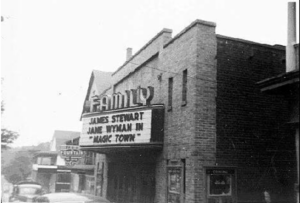1957 Glen Lyon, Pennsylvania
Mary Ann Murphy
1947
Glen Lyon, Pennsylvania
Interviewed on February 12, 2021
by Henry Smith
I was about ten years old in 1957 when my family moved to the east side of the coal breaker dividing my hometown of Glen Lyon. Almost every weekend, I met my friends from the west side as they walked to Family Theatre. Walking with my friends to the theatre became something to which we looked forward—the camaraderie of it. My friends and I habitually talked on the phone after school; that was a big thing in those days—talking on the phone with your friends. I had a whole group of girl friends, and we would excitedly call each other to plan trips to the theatre. Frankly, at that age, I was more enthusiastic about being with my friends than paying attention to the movie itself. The Family Theatre was small, and so it was usually busy, particularly for its later weekend shows; we always opted for the earlier showings, at four or five o’clock.
Although I do not recall any particular full-length movies at the Family Theatre, I remember that they showed one particular series of shorts, Zorro, before the main feature. In 1957, Walt Disney produced Zorro for television, but we watched the show when it was streamed at the theatre. Zorro was a big deal for us, we could not wait to see what next week’s episode would bring. My girl friends and I would get to the theatre early just to see Zorro. It was a big attraction, perhaps even more so than the movie itself. Thinking back on my moviegoing experience, I vividly remember the opening scene of each episode in which Zorro would appear on the screen and do a few turns in front of the audience; he would then slash his iconic ‘Z’ through the movie screen with his sword. I can most distinctly picture the ‘Z’. Zorro always wore a cape, a mask, and a hat—a black hat. The series took place in 1820s California prior to statehood and centered on Don Diego, a Robin Hood-like character. Don Diego was an unsuspecting character during the day, blending in with everybody else, and then became Zorro at night. Zorro represented the moral good in society—he was always rescuing somebody in trouble, people who were treated unjustly.
The Family Theatre was the only place in town to watch a movie. Your grandfather (who had also grown up in Glen Lyon) and I did not know each other at that time, but we had undoubtedly crossed paths at the theatre before we first met. I have one particular memory in around sixth grade when I sat next to a boy who was interested in me. He asked “Would you pick something up for me,” and then kissed me on the cheek. My first kiss was at the movies!

Upon arriving at the theatre after our walk, we would wait outside to buy our tickets at the glass-enclosed ticket booth, talking with the ticket person through the speaker. I would always be eager to buy a snack during my movie outings. I typically ordered popcorn and a Coke, of course. I remember that they would put the popcorn in a paper bag; it felt like a big attraction to me. My family never made popcorn at home—that was something special reserved for the movies. In the theatre itself, you would often see bats flying around when you were watching a film, their silhouettes appearing on the screen. This was particularly true in the State Theatre, a theatre located in the neighboring town of Nanticoke, which had high ceilings. We typically sat two-thirds of the way back in the theatre, and so we were not scared by the bats; they were probably attracted to the light from the projector during the show. After the film, my girl friends and I would usually go to a pizza shop afterward. I would always enjoy reliving the movie-watching experience over a warm slice of pizza, talking about how scared we were had we seen a thriller. By the time I was sixteen, the Family Theatre had closed and was converted into a factory; I do believe, however, that the building is still standing today.
